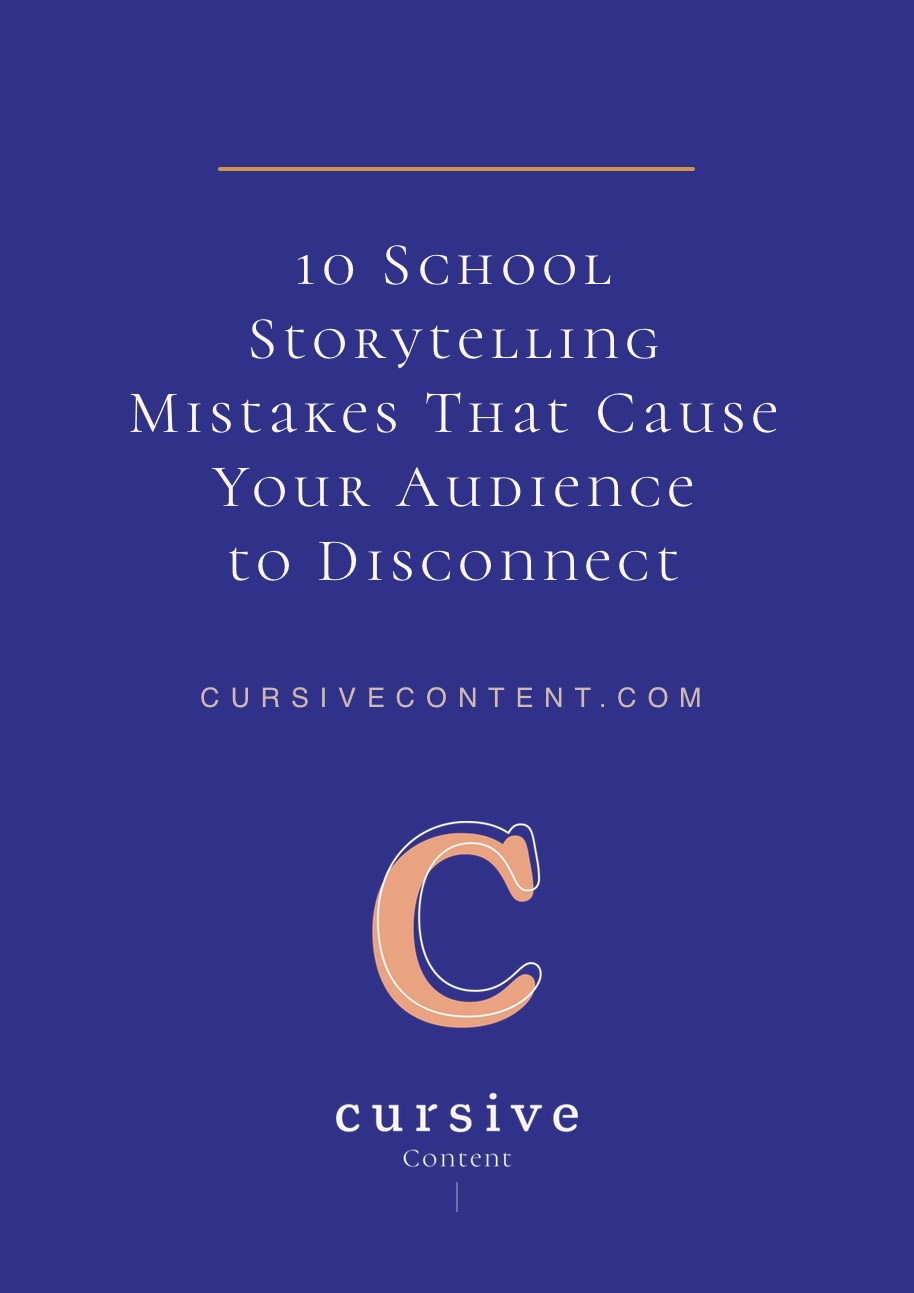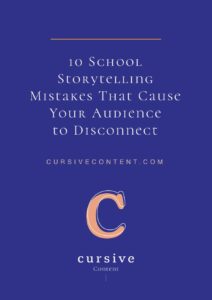10 School Storytelling Mistakes That Cause Your Audience to Disconnect

If your content isn’t resonating with your audience, it might be caused by one (or more) of these common problems.
The good news? They each have completely doable fixes, so even if you have gone slightly astray, it’s not too late to bounce back.
#1: YOU AREN’T BEING REAL
Your school’s brand voice should be clear in every piece of content you produce. Your audience will detect anything that’s wildly out of line with who you are. It’s like when your grandpa tells you he’s “jiggy with it”. He is actually so disconnected from modern slang that he’s using terminology that instantly dates him—but he thinks he’s being cool. It’s inauthentic and…awkward.
The fix: Stop being something you aren’t and just be you—that’s what people want. Define your tone on each platform. It might vary slightly, but it should still fit with your overall brand voice.
#2: YOU BORE PEOPLE
Facts and statistics can be powerful, and there is definitely a place for them, but too many statistics can make a blog post feel like a research report. You are more likely to create a piece that resonates with people if you weave in real-life stories and examples.
The fix: Whenever possible, find case studies, stories of student’s accomplishments, alumni success stories, and other examples that can both illustrate your point and create more of a narrative. Numbers can also be a powerful tool to provide support for opinions, but use them sparingly (think bullet points, not rambling paragraphs).
#3: YOU ALWAYS DO THINGS EXACTLY THE SAME WAY
There are so many times consistency is good—publishing new content on the same day each week, for example. But when your predictability extends to always using the same content formats and platforms, the same topics and structure, you might be boring your audience.
The fix: A vital part of maintaining a healthy school storytelling approach is to regularly evaluate your progress. Every three or six months, sit down with your team to brainstorm new approaches. This might mean developing a presence on a new social network, expanding your content to include video, adding new topics to your repertoire, etc. By keeping things fresh, you are more likely to keep you audience engaged.
#4: YOU DON’T KNOW YOUR AUDIENCE
When you aren’t sure who you are creating content for, you end up guessing. And most of the time, you end up guessing wrong—or just writing content that makes you happy (and you are rarely your audience). Things can really start to unravel when your audience doesn’t feel like your content is for them.
The fix: Gather all the analytics you can. Survey current and prospective students and their families. Find out who they are and what they care about. Start creating content for them and no one else.
#5: YOU DON’T THINK ABOUT WHAT MAKES CONTENT INTERESTING
A strange thing often happens to marketers when they create new content—they’re so focused on the jumble of ideas they want to make in any given piece of content, that they forget to try to make it interesting. But what good is fitting all of your very important talking points if your audience is so uninterested they tune out after the first three?
The fix: Think like your audience. What makes you want to read, watch, or listen to things? Take a look at what grabs your attention and figure out why and how it did. Then seek to recreate that same pull in your own content.
#6: YOU JUST REGURGITATE OTHER PEOPLE’S THOUGHTS
Current students don’t have to read, watch, or listen to most of what you create. Prospective students don’t have to pay attention to you, and are likely considering at least a few different school options. So, if these people find themselves watching your video, reading your blog post or listening to your podcast, what they want to hear is YOU. If you aren’t sharing any original thoughts and ideas, you’re almost guaranteed to blend in, and they are almost guaranteed to zone out.
The fix: Look at things from a unique perspective. Add in your opinion, encourage a different way of thinking, highlight new points. Give your audience a little more of your school, and don’t be afraid.
#7: YOU CAN’T ANSWER “WHY?”
If you created an eBook because you thought you had to have one, it’s probably not a good idea. If you developed a video just because you had leftover money in your budget, that’s also not the best reasoning. The point of each piece of content you create should be clearly defined, and you should choose the format accordingly. If your goal was just to create something, that apathy/ disconnection will come through. That’s bad for your audience (they aren’t likely to be motivated to do anything as a result of that content) and bad for you (because you have an unmotivated audience who is also a bit unimpressed).
The fix: Define your goals and refer back to them often; they should drive your approach to everything you do. Think in terms of both short- and long-term goals, since what you do now affects both.
#8: YOUR CONTENT IS FILLED WITH JARGON
Insider terms and buzzwords might make you feel professional and elite, but the reality is that they often confuse your audience, diminish your point, and make you indistinguishable from competing schools. Simple and straightforward is better.
The fix: Review your content for the buzzwords, phrases, and insider lingo you use often, and seek to eliminate that language from your vocabulary.
#9: YOU’VE CREATED A ONE-WAY STREET
Prospective students and families like to connect with schools, and the increase in technology and social media has provided a way to put real people behind school names. It has become expected that you will not only provide multiple ways for your audience to connect with you, but also that you’ll talk back. So if you are ignoring blog post comments and don’t engage on social media, that seems pretty harsh to your audience.
The fix: Set up notifications to make it easier for you to respond to each comment. Even a simple “thank you” message in response to a compliment can do wonders for upping your school’s image—in the eyes of the person who left the comment, as well as others who see it. Take every opportunity to make the conversation a two-way street.
#10: YOU DON’T ENCOURAGE ENGAGEMENT
If you don’t ask people to leave a comment, read a related article, or download your eBook, guess what? They probably won’t. So every time you aren’t encouraging your reader to dig a little deeper, you’re missing a huge opportunity to position yourself as even more of a helpful resource.
The fix: Include a call-to-action on every piece of content, and take advantage of opportunities to point prospective students and families to related content that might be of interest to them.
Have you been making any of these common mistakes? It’s ok, we see them all the time—and we’ve also seen some clients recover from them beautifully. If you need extra guidance, learn more about how Cursive can help support you.
MORE ARTICLES
-
 What Is Your Private School’s Bold & Unifying Big Promise?
What Is Your Private School’s Bold & Unifying Big Promise? -
 AI Writing Prompts to Power Private School Storytelling
AI Writing Prompts to Power Private School Storytelling -
 When to Outsource Your Private School Content Marketing to an Expert
When to Outsource Your Private School Content Marketing to an Expert -
 3 Unique Ways to Attract Dream Families with Content
3 Unique Ways to Attract Dream Families with Content -
 4 Quick & Easy Ways to Improve Your School’s Emails
4 Quick & Easy Ways to Improve Your School’s Emails -
 The Best Content Marketing Resources for Independent Schools
The Best Content Marketing Resources for Independent Schools -
 How to Create Qualified Leads for Your Private School
How to Create Qualified Leads for Your Private School -
 Does Your School’s Content Answer The Ultimate Content Marketing Question?
Does Your School’s Content Answer The Ultimate Content Marketing Question?

